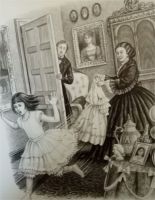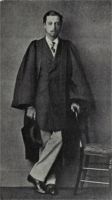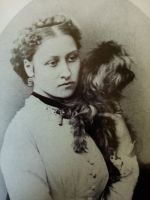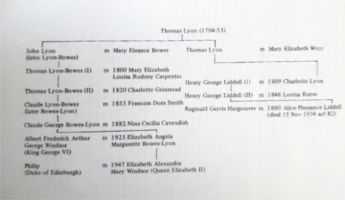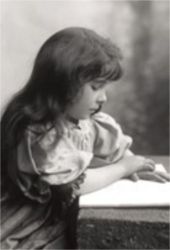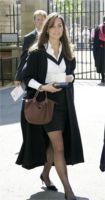Royal Connection with Lewis Carroll and Alice Liddell
This article was given as a talk by Stephen Martin at the Societies' spring meeting on 10th June 23.
In the Alice books there are several references to royalty: "A cat may look at a King", "Let's pretend we're Kings and Queens", and "To be a queen! How grand it sounds"- these are three examples that came to mind. The first is a proverb and implies that someone of a lesser station may have contact (if not altogether converse) with a monarch. The last two refer to the children's game of dressing up and play acting as royalty.
The Dodgson family ancestry can be traced back to King Edward lll (1312-1377), John of Gaunt, Duke of Lancaster (1340-1398), Joan de Beaufort (1385-1440), Eleanor Neville, Countess of Northumberland (1407-1440), through the Percy, Harbottle, and Fitton families, John Skeffinton(1629-1695) 4th Baronet, Mary Skeffinton (2655+1732) who married Charles Houghton (1694-1780), Henry Lutwidge(1724-1798), and Charles Lutwidge (1694-1848). Sir Charles Houghton was a descendant of Lucia, sister of the earls Edwin and Morcar at the time of the Norman Conquest. In Alice's Adventures in Wonderland the mouse claims this period in history is "the driest thing l knows". Roger Llancelyn Green claimed that Lewis Carroll could not have known about his relationship to these earls or otherwise he would not have made fun of them in this passage.
The first contact the Liddell's had with royalty was when the Prince of Wales came to study at Christ Church in 1859 and he became a frequent visitor to the Deanery. On one shocking occasion His Highness arrived unannounced and the butler admitted him into the drawing room where Alice was being fitted for a new frock by the dressmaker. Alice was attired in only her petticoat when the Prince entered and Alice, alarmed, had to rush into a side room, sending pins flying. On taking his leave, the Prince coyly added "Tell Alice I saw her ''.
Queen Victoria paid a surprise visit to Oxford on 12th December 1860 and the Liddell children presented a tableaux vivant as part of the evening's entertainment at the Deanery. During the evening Dodgson caught sight of Queen Victoria for the first time, but was not impressed by her appearance, writing home to his family that he found the Queen to be "short", "dumpy" and "plain".
The newly married Albert Edward, Prince of Wales, and his wife Alexandra of Denmark visited Oxford for the end of their honeymoon in mid June 1863 and stayed three days at the Deanery which involved a lot of preparation for Mrs Liddell. The Prince was to have been godfather at the christening of Lorina's new baby who was named Albert Edward, but he died at the end of May. On 16th June in the grounds of Tom Quad the degree ceremony for the Prince took place and was followed by the princess presenting prizes to the University Volunteers. It poured with rain so the royal couple, the Liddell family, and the dignitaries needed to shelter under an awning, Dodgson watched the proceedings through his telescope from a window opposite. In the afternoon there was a bazaar held in St John's garden in aid of the Radcliffe Infirmary. Alice asked Dodgson, as she was too shy, to ask the princess on her behalf to buy a kitten but she had already bought one from Ina. In the evening there was a great banquet in Christ Church hall. On the frontage of St Algates there were gas lit illuminations depicting the prince's coat of arms, the couple's initials, and a crown. Some of these events found their way into Alice Through the Looking Glass.
The most persistent connection between Queen Victoria and Lewis Carroll is that the sovereign was so delighted by Alice’s Adventures in Wonderland that he should send her his next book and he duly presented her with a copy of Condensation of Determinants, but which Dodgson dismissed as a 'silly story', 'absolute fiction', and 'that it is utterly false in every particular: nothing even resembling it has occurred'.
At Windsor in 1865 Dodgson saw the Queen driving by in an open carriage and got a bow all to himself. Lady August Stanley, a member of the Queen's Court, showed her some of Dodgson's photographs, she replied "Her Majesty admirers them very much. They are such as the Prince would have appreciated very highly and taken a pleasure in". The Queen declined to allow Dodgson to photograph her youngest daughter 7- year old Beatrice, known affectionately as "Little Butterfly", but he did pass onto the child a German translation of Alice (now in the Windsor Castle archives).
In an amusing letter to Margaret Cunningham (dated 1868) about a photograph of himself he had presented to her personally, he wrote "As a great secret (please don't repeat it), the Queen sent to ask for a copy of it, but as it is against my rule to give in in such a case, I was obliged to answer- 'Mr Dodgson presents his compliments to Her Majesty, and regrets to say that his rule is never to give his photograph except to young ladies'. I am told she was annoyed about it, and said I’m not so old as all that comes to!' and ‘one doesn’t like to annoy Queens…'
Alice's name became linked to the next royal visitor, for Queen Victoria's youngest son Leopold came to Oxford in 1872, and the Dean took him under his wing. Tongues started tongues to wag. The fact that Alice was unattached, and word had it that Mrs Liddell found every opportunity to get the pair together: a romance blossomed. If Alice could not quite make queen (as she had done in Through the Looking Glass) then a princess would be quite acceptable. However, Queen Victoria had other ideas, and Prince Leopold married Princess Helen Frederica Augusta of Germany in April 1882. On Alice's marriage to Reginald Hargreaves in 1880 she wore a pearl horseshoe broach given to her by Leopold, he sent this message: "warmest & heartfelt wishes for your future happiness" adding "l shall think much of you & your parents tomorrow". Interestingly Alice named her second son Leopold born January 1883 and asked the Prince to be his godfather. Leopold repaid the compliment by naming his daughter Alice (born 25th February 1883).
The Prince wearing his academic gown and holding his mortarboard cap posed for Dodgson's camera in his studio on 25th June 1875, it had been organised by his tutor Robert Hawthorne Collins and who was in attendance. Prince Leopold and his wife moved into Claremont House in Surrey (now a National Trust property) where their two children Alice and Charles Edward were born. Prince Leopold suffered from haemophilia from being a child, he had a fall injuring his knee and hitting his head, he died on 28th March 1884 at the age of 30.
The first time Dodgson met the Duchess of Albany socially, after she was widowed, was on a three day stay at Hatfield House, the home of Lord Salisbury, in early June 1889. He found himself seated next to her at a luncheon and breakfast with her two children, he found her 'very pleasant indeed' and they enjoyed good conversation. From Hatfield Dodgson jokingly wrote to lsa Bowman: "Now that I have made friends with a real live little Princess, I don’t intend to speak to any more children that haven’t titles. In fact, I’m so proud, and l hold my chin so high, that l shouldn't see you if we meet". Dodgson's initial reaction to Princess Alice was "a sweet little girl though rather unruly high spirited". Princess Alice recalled the reason for this in her autobiography ‘For my Grandchildren’ (1966): "Doctor Dodgson or 'Lewis Carroll' was especially kind to Charlie and me, though when l was only five l offended him once when at a children's party at Hatfield, he was telling us a story. He spoke with a stammer and being unable to follow what he was saying, l suddenly asked in a loud voice, "Why does he waggle his mouth like that?” l was hastily removed by the lady-in-waiting. Afterwards he wrote that he 'liked Charlie but thought Alice would turn out badly. He soon forgot all this and gave us books for Christmas with anagrams of our names on the fly-leaf". Princess Alice lived a long and eventful life dying at 97 in 1981.
The Reverend Robinson Duckworth (he accompanied Dodgson and the Liddell girls on the 4th July 1862 boating expedition when the famous story was told) became the tutor to Prince Leopold in 1866, according to Elizabeth Longford his sister Princess Louise developed her first girlhood loves for Duckworth. In 1960 Duckworth's nephew wrote that the Princess had great affection and wished to marry his uncle, she gave him a ruby, diamond, and signet ring with a lock of her hair. Duckworth was dismissed from the post, and a rumour spread that she had given birth to an illegitimate child. The Royal archive have never allowed anyone access to documents concerning this matter.
Alice has Royal connections with the Lyon family and the Earls of Strathmore, the link being with the 8th earl Thomas Lyon, his son Thomas married Mary Wren, and their daughter Charlotte married Henry George Liddell in 1809. She of course was Alice's grandmother.
Claude George Bowes-Lyon, Lord Glamis married Nina Cecilia Cavendish in 1882. Their youngest daughter Elizabeth Angela Marguerite was born in 1900 and spent most of her childhood at the ancestral fairy-tale palace of Glamis Castle in Scotland. In the early 1920,s Elizabeth was part of the ladies society group called The Mad Hatter's along with Lady Lavinia Spencer, the aunt to Princess Diana. She married Prince Albert at Westminster Abbey on 26th April 1923 becoming the Duchess of York. Princess Elizabeth, her pet-name being 'Lilibet', was born in 1926 and their second daughter Margaret Rose was born in 1930 at Glamis. She met the writer of Peter Pan James Matthew Barrie at her third birthday party and they got on so well that she announced "He is my greatest friend and l am his greatest friend". King George VI ascended the throne in 1936 and Elizabeth was crowned in 1952 and became the longest reigning monarch in history. This made the Queen third cousins three times removed from Alice.
Princess Diana wished to be known as the 'Queen of Hearts' in the affections of the public.
Catherine "Kate" Middleton began studying art history at St Andrews in 2001. She decided that for her 4th year undergraduate art history dissertation was to study the photography of Charles Dodgson. In November 2004 she emailed the Lewis Carroll Society secretary Alan White for advice, he immediately contacted the Carrollian scholar Edward Wakeling with these words "Edward, This one is up your street, l think". On 29th November Edward replied back to Kate enquiring " you are looking at Carroll's photos from an aesthetic point of view". He recommended these books to her:- Dreaming in Pictures by Doug Nichol, Lewis Carroll Photographer by Roger Taylor, Pictures of Innocence be Anne Higgonnet, and Pleasures Taken by Carol Mavor.
Much to Edward's surprise Kate replied back to his email thanking him for his help and guidance (1st December). She wrote "...as you say we have to be careful of misinterpretation of Carroll, for this reason I hope to consider Lewis Carroll's photographs in the context of mid- Victorian tradition. I have been carefully analysing the essence of childhood and the social expectations and views which society placed on children. It is these ideas that I will then discuss Lewis Carroll's early photography (i.e. those taken between 1856-62) and compare it to his later photographs (those taken in the 1870,s & 80,s) in his private Oxford studio." She went on to say that her thesis would include the Aesthetic Movement and its principles. She stated that there was plenty of room for modification and no doubt it will be constantly changing. The finished dissertation was titled "Angels from Heaven: Lewis Carroll's interpretation of Childhood". Kate graduated with a 2:1 (Upper Second) MA degree. The content of the dissertation has never been made available for public display.
It was during her time at St Andrews that her romantic relationship with Prince William of Wales began, they became engaged in November 2010, and married on 29th April 2011 at Westminster Abbey. The Duchess of Cambridge became the patron of the National Portrait Gallery and she contributed her own views for the exhibition "Victorian Giants: The Birth of Art Photography" which included Lewis Carroll, Julia Margaret Cameron, Lady Hawarden, and Gustave Rejlander.
She said: "These photographs allow us to reflect on the importance of presenting and appreciating childhood while it lasts. Children held a special place in the Victorian imagination and were celebrated for their seeming boundless potential. This notion still rings true for us today and it underpins much of my official work and Charities…"
When Kate's daughter Princess Charlotte Elizabeth Diana was born on 2nd May 2015 the firm Hazle presented her with a ceramic model of the Alice Shop on St Algates in Oxford to celebrate the 150th anniversary of Alice in Wonderland in 2015.
Kate's love of amateur photography was encouraged by her paternal grandfather Peter Middleton who showed her how to use a camera and take pictures. She has become an accomplished photographer herself and has taken intimate and relaxed pictures of her children Prince George, Princess Charlotte, and Prince Louis, and she submitted these photos to the 'Life through the Royal Lens' exhibition at Kensington Palace in 2022.
Stephen Martin.

